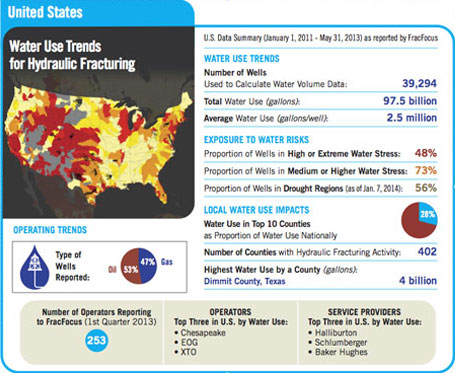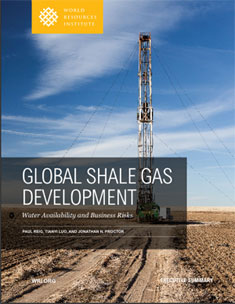|
Conservation Issues |
 |
Development in Arid or Drought Areas
Drought restrictions on water use are currently dealt with at the local level. In drought-stricken areas concern is particularly high over water used for well stimulation, for example, in 2011, the municipality of Grand Prairie, Texas banned the use of city water for hydraulic fracturing. However, the proportion of domestic water use in oil and gas development to total domestic water use is less than 0.1%.
In their 2014 report Hydraulic Fracturing & Water Stress, the non-profit organization Ceres reported that nearly half of the 39,294 reported hydraulically fractured wells drilled in the U.S. since 2011 (just over 18,000 wells) are in regions with high or extreme water stress. Over 28,000 wells, or 73 percent, are located in regions of at least medium water stress. In extreme water stress regions, municipal, industrial or agricultural users are already using over 80 percent of the annual available flows (from both surface water and shallow groundwater). In high stress regions, 40 to 80 percent is already allocated. Hydraulic fracturing in the U.S. is largely taking place in regions already experiencing high competition for water.
For a series of interactive maps presenting the competition for water, drought areas, and groundwater depletion overlaid by areas of shale energy development, click here: Ceres: Hydraulic Fracturing & Water Stress
Increasing recognition that regional economic reliance on groundwater in many regions may not be sustainable and that groundwater withdrawals by all users must be carefully balanced with declining groundwater levels and impacts on surface water flows. Another level of added complexity concerning oil and gas development in many western states is prolonged drought conditions, growing climate change impacts, and anticipated population growth. Texas, Colorado, Oklahoma, Wyoming, New Mexico, and California are all expected to experience 20 percent or higher population growth by the end of the decade. Texas is projected to experience an 80 percent growth in population by 2060. For the full report from Ceres, see: Ceres: Hydraulic Fracturing & Water Stress: Water Demand by the Numbers

For a global picture of water for oil and gas development, see Global Shale Gas Development: Water Availability and Business Risks.
|

